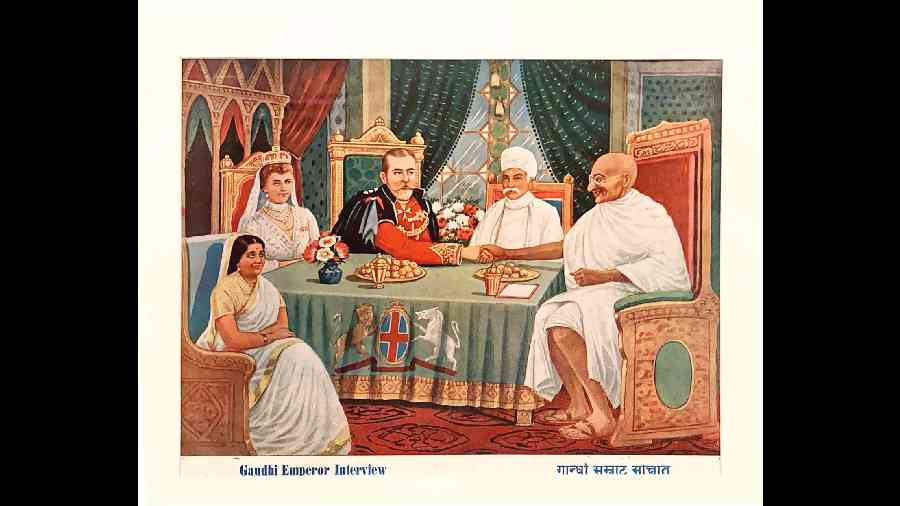Book: Insurgency And The Artist: The Art Of The Freedom Struggle In India
Author: Vinay Lal
Publisher: Roli
Price: ₹2,495
Vinay Lal sums up the focus of his research succinctly. The material he was chasing — prints, handbills, calendars, advertisements, pamphlets related to India’s freedom movement — could be deemed “the third world of the scholarly gaze, barely worthy of critical scrutiny.” But then, the contemporary recognition of marginal narratives and oral histories in illuminating a dominant discourse with plural, parallel perspectives makes such a project worthwhile, even necessary.
And what is this parallel perspective that engages Lal? The visual response of artists and print-makers to the freedom struggle and how “the political image” may have actually “helped to make the nation”. For, with leaders of epic proportions — from the frail naked fakir in his “minus fours” to the magnetic Subhas Bose to the fiery brigade of the HSRA — and episodes of high drama and stirring emotionalism like Jallianwala Bagh, Chauri Chaura, the Dandi March, the reckless courage of Matangini Hazra and so forth, the movement did not lack a spectacular dimension.
Yet, though India’s anti-colonial struggle keeps scholars busy with differing interpretations and micro histories, how and what kind of image-production was stimulated by the churning hasn’t caught their enquiring imagination, barring an exception Lal mentions — Christopher Pinney, who was in search of “… not a history of art, but a history made by art…” in his Photos of the Gods: The Printed Image and Political Struggle in India. In it, he insightfully describes the aesthetic of the television serial, Ramayana, as being “derived from that of chromolithography”.
What concerns Lal, though, is the visual record produced during the freedom movement, ending with the assassination of Gandhi. That is partly why Ambedkar doesn’t figure in this chronicle of images. Because, explains the author, “the popular iconography of Ambedkar only begins to develop in the 1960s.” And also because, though his historic role in India’s resurgence can hardly be overstated, the father of the Constitution didn’t participate in the political agitation per se. Perspicaciously, however, Lal includes Benode Behari Mukherjee’s mural at Santiniketan’s Hindi Bhavan, Life of Medieval Saints (1946-47), arguing convincingly how, in embodying a pan-Indianness of vision and values, it becomes “political art”.
Being both a professor of History and Asian American Studies at UCLA and a cultural critic, Vinay Lal may be just the doctor to recover this neglected field in Insurgency and the Artist: the Art of the Freedom Struggle in India. Especially since his eye was tutored to read images some four decades ago by classics such as Erving Goffman’s Gender Advertisement and — but, of course — John Berger’s Ways of Seeing.
Plunging into the project, the author was in for a disappointment: few notable artists had responded to the movement itself in the established media. It is, in fact, the lesser known and unknown artists and print-makers who make it a fascinating collection. And Shyam Sundar Lal’s press in Kanpur was most prolific in publishing prints that risked provoking the authorities. Although the book follows chronology, starting with the Revolt of 1857 and ending with Partition and Gandhi’s death, what decides the chapters are their themes: Hindu mythology, the concept of Bharat Mata, the life of Gandhi, the drain of wealth or “sampatti haran” and so forth.
If Zainul Abedin, Somnath Hore, Quamrul Hassan and Chittaprosad — who’d discarded his Brahmin surname along with his so-called sacred thread — present the people as the suffering but defiant poor with no religious or caste identity, Hindu nationalism, inspired by Tilak’s Ganapati and Shivaji festivals, no doubt, seek in Shivaji, Prithviraj and Rana Pratap historical role models, anticipating the contemporary agenda of exploiting the past for political gains. In fact, Gandhi himself is seen as an “avatar of the gods” and woven into myths re-invented as political assertions. It needs a Gaganendranath Tagoreto import a dry wit into the often overcharged atmosphere with cartoons.
As the author rues, Dalits, Muslims, adivasis and Sikhs have no place in this gallery. An exception is a fine pencil sketch of Birsa Munda, 1942, by Upendra Maharathi. And there’s a print portraying the Ali Brothers and Their Mother. Among those who are part of the popular political pantheon are Laxmi Bai, Subhas Bose, Bhagat Singh and the main disciples of Gandhi: Nehru, Patel, Azad, C.R. Das and such.
It is Gandhi, however, who leaves others far behind when it comes to his charismatic appeal to a great majority of Indian image-makers, including Nandalal Bose, whose tribute to Gaffer Khan has also been included. But this three-piece suit barrister from England was, to the Westerner, utterly baffling in his loin cloth and the new political language he’d been evolving, summarised by Auckland Star’s cartoonist, J.C Hill. No wonder that by 1931 he’d become the Most Talked About Man in the World (sic), according to the Burlington Hawk-Eye.
Could anybody dare to contest his status as the Father of the Nation?










